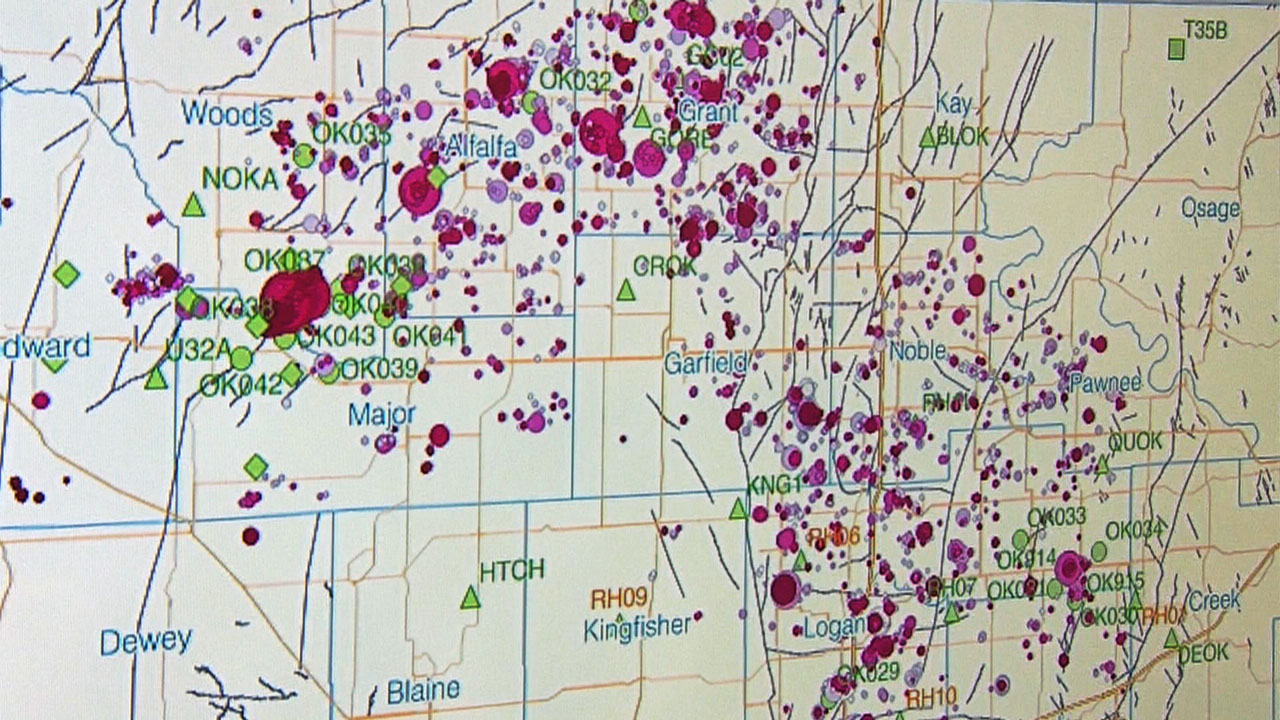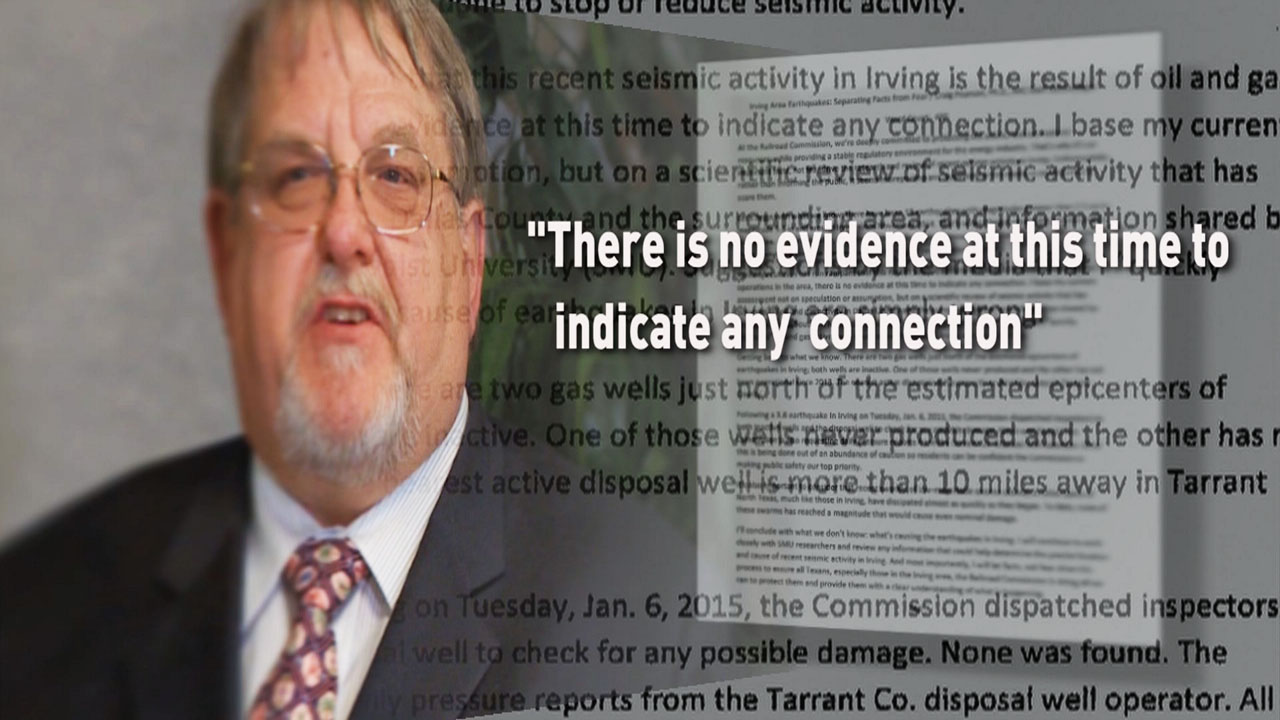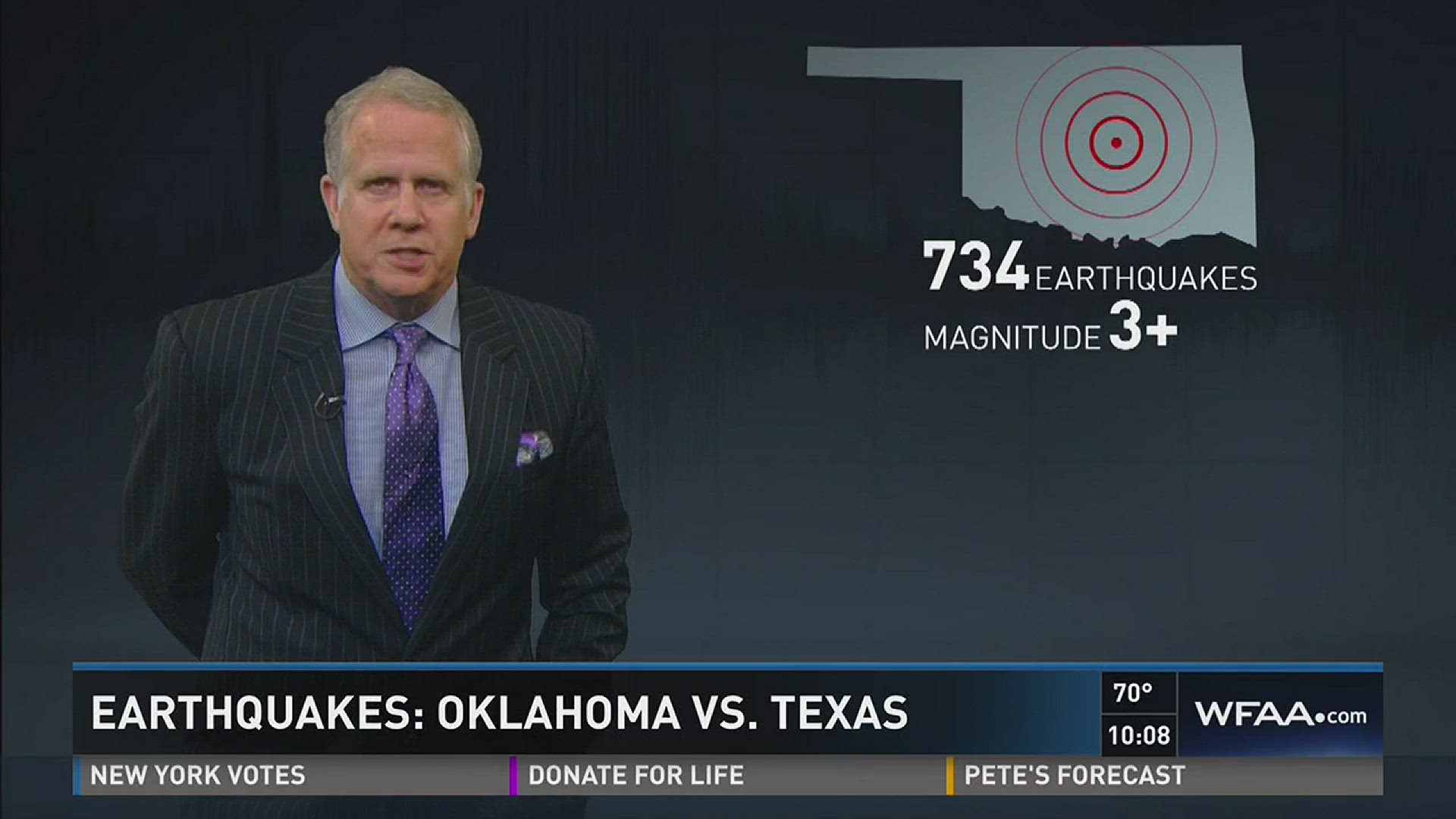The U.S. Geological Survey recently released a study indicating North Texas faces an increasing risk of a damaging earthquake in the coming year.
Scientists blame man-made activity, specifically drilling-related saltwater injection wells.
It’s a concept that most scientists and government officials in the United States have embraced -- except in Texas, where the state’s top oil and gas regulators say the jury is still out.
Oklahoma, though, has good reason to follow the science.
In the Dallas-Fort Worth area, there have been 19 quakes of magnitude 2 or higher in the past year.
But cross the Red River to Oklahoma and you’ll see where the real action is. There have been 734 quakes of magnitude 3 or higher in the past year.
Scientists say enough of these tremors have erupted that Oklahoma has now passed California as the earthquake capital of the United States of America.
Oklahoma earthquakes
The folks in Fairview, Oklahoma have felt their share.
Many of the earthquakes that have rattled the rural northwest part of the state are magnitude 3, sometimes 4. But on February 13, a big one hit -- a 5.1 magnitude quake – the third biggest to ever hit Oklahoma.
There were no injuries and little damage, and according to scientists, little doubt about what caused it and the hundreds of others: Activities related to the oil and gas industry.

Specifically, scientists say that the injection of drilling waste (usually saltwater) back into the earth intersects with deep underground fault lines to produce earthquakes.
“As you begin to pump water into them, it kind of presses them apart a little bit; it relieves that closure pressure and you can actually get a fault slipping,” explained Jeremy Boak, director of the Oklahoma Geological Survey at the University of Oklahoma in Norman.
And once that connection to oil and gas was established, it didn’t take upset citizens long to demand that politicians respond.
“There are still leaders who don’t believe there’s a connection between wastewater injection wells and earthquakes,” Ladonna Sharp told KOCO-TV in Oklahoma in during a public forum in February featuring activist Erin Brockovich, who urged citizens to demand action.
Oklahoma once was the oil capital of the world. An oil derrick sits just a few feet from the Capitol steps in Oklahoma City. So surely the prospect of a political and regulatory solution to the earthquakes would be next to impossible.
Well guess what?
“My task from the governor was make the induced earthquakes stop,” said Michael Teague, Oklahoma’s Secretary of Energy and Environment, which has reams of data and information online addressing the problem head-on.
He said there is no question as to the cause of the shaking in his state.
“These earthquakes are absolutely correlated and tied to disposal of saltwater,” he told WFAA in a recent interview.
To limit the damage and reduce the number of quakes, Teague and other Oklahoma leaders have brokered a solution with the oil and gas industry, which has agreed to reduce the volume of wastewater injected back into the earth.
Teague said they are already seeing a slight reduction in quakes.
What kind of pushback is he getting from industry? “Zero. Absolutely zero. Why? They live here.”
Back in Texas
Meanwhile, back in Texas, our oil and gas regulators, the Texas Railroad Commission, says there is no evidence to conclude that earthquakes in this state are in any way tied to the oil and gas industry.
A Commission spokeswoman said her agency has some of the most stringent waste injection rules in the nation. The Texas Legislature has set aside $4 million to establish an earthquake monitoring program in Texas called TexNet.
Texas officials also say they have already limited new injection well permits and in some cases required new wells to pump less waste.
But unlike Oklahoma, Texas leaders maintain they have found no link between North Texas earthquakes and injection well activity.
Two years ago, the Railroad Commission hired a state seismologist, Dr. Craig Pearson, to evaluate seismic activity as it relates to injection activity.

But in the course of those two years, Pearson has published one report: A one-page position paper stating “there is no evidence at this time to indicate any connection” between earthquakes in North Texas and injection well activity.
Pearson is still employed by the Texas Railroad Commission. He is paid a salary of $102,000 per year. We asked to interview Pearson about his position on earthquakes and injection wells. He declined.
Through the Texas Public Information Act, we asked for any other reports or position papers he has submitted in his official capacity. We were given none.
We asked to see Pearson’s daily activity calendar for the past year. His calendar is mostly empty.
We asked to see his emails from January through mid-March of this year. Pearson sent one, to a co-worker, asking “Are you in the office today?”
Texas Railroad Commission officials also declined to be interviewed about the agency’s position on earthquakes and injection well activity.
But environmentalists are happy to weigh in. They say the contrast between the Oklahoma and Texas response is as jarring as the tremors themselves.
“They deny that there is any relation to fracking-related earthquakes and seismicity,” said environmental activist Sharon Wilson. “They wanted a seismologist who would deny the science of fracking-related earthquakes.”
Here is the text of Craig Pearson's statement
Craig Pearson, Ph.D., Railroad Commission of Texas Staff Seismologist
At the Railroad Commission, we’re deeply committed to protecting the public, and our natural resources, while providing a stable regulatory environment for the energy industry. That’s why it’s so important facts, not fear drive the research and review of recent seismic activity in Irving. Unfortunately, rather than informing the public, it seems misreporting and hyperbole in the media is serving only to scare them.
Let’s begin with what we know: there have been 18 earthquakes with magnitudes greater than 2.5 up to magnitude 3.6 in and around Irving since November 2014. That’s when I began reviewing seismic events in the area. Understandably, residents of the region want to know what’s causing them, and whether there is anything possible that can be done to stop or reduce seismic activity.
While speculation has run rampant that this recent seismic activity in Irving is the result of oil and gas operations in the area, there is no evidence at this time to indicate any connection. I base my current assessment not on speculation or assumption, but on a scientific review of seismic activity that has occurred, all oil and gas activity in Dallas County and the surrounding area, and information shared by researchers with Southern Methodist University (SMU). Suggestions by the media that I “quickly dismissed” oil and gas activity as a cause of earthquakes in Irving are simply wrong.
Getting back to what we know. There are two gas wells just north of the estimated epicenters of earthquakes in Irving; both wells are inactive. One of those wells never produced and the other has not been operational since 2013. The nearest active disposal well is more than 10 miles away in Tarrant County.
Following a 3.6 earthquake in Irving on Tuesday, Jan. 6, 2015, the Commission dispatched inspectors to both inactive wells and the disposal well to check for any possible damage. None was found. The Commission is also requesting daily pressure reports from the Tarrant Co. disposal well operator. All of this is being done out of an abundance of caution so residents can be confident the Commission is making public safety our top priority.
It’s also important to consider that recent swarms of low-magnitude seismic activity in other parts of North Texas, much like those in Irving, have dissipated almost as quickly as they began. To date, none of these swarms has reached a magnitude that would cause even nominal damage.
I’ll conclude with what we don’t know: what’s causing the earthquakes in Irving. I will continue to work closely with SMU researchers and review any information that could help determine the precise location and cause of recent seismic activity in Irving. And most importantly, I will let facts, not fear drive this process to assure all Texans, especially those in the Irving area, the Railroad Commission is doing all we can to protect them and provide them with a clear understanding of what is happening.

